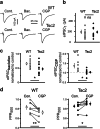Presynaptic GABAB receptor-mediated network excitation in the medial prefrontal cortex of Tsc2+/- mice
- PMID: 34279736
- PMCID: PMC8302497
- DOI: 10.1007/s00424-021-02576-5
Presynaptic GABAB receptor-mediated network excitation in the medial prefrontal cortex of Tsc2+/- mice
Abstract
The TSC1 and TSC2 tumor suppressor genes control the activity of mechanistic target of rapamycin (mTOR) pathway. Elevated activity of this pathway in Tsc2+/- mouse model leads to reduction of postsynaptic GABAB receptor-mediated inhibition and hyperexcitability in the medial prefrontal cortex (mPFC). In this study, we asked whether presynaptic GABAB receptors (GABABRs) can compensate this shift of hyperexcitability. Experiments were performed in brain slices from adolescent wild-type (WT) and Tsc2+/- mice. Miniature and spontaneous postsynaptic currents (m/sPSCs) were recorded from layer 2/3 pyramidal neurons in mPFC using patch-clamp technique using a Cs+-based intrapipette solution. Presynaptic GABABRs were activated by baclofen (10 µM) or blocked by CGP55845 (1 µM). Independent on genotype, GABABR modulators bidirectionally change miniature excitatory postsynaptic current (mEPSC) frequency by about 10%, indicating presynaptic GABABR-mediated effects on glutamatergic transmission are comparable in both genotypes. In contrast, frequencies of both mIPSCs and sIPCSs were suppressed by baclofen stronger in Tsc2+/- neurons than in WT ones, whereas CGP55845 significantly increased (m/s)IPSC frequencies only in WT cells. Effects of baclofen and CGP55845 on the amplitudes of evoked (e)IPSCs confirmed these observations. These data indicate (1) that GABAergic synapses are inhibited by ambient GABA in WT but not in Tsc2+/- slices, and (2) that baclofen shifts the E/I ratio, determined as the ratio of (m/s)EPSC frequency to (m/s)IPSC frequency, towards excitation only in Tsc2+/- cells. This excitatory presynaptic GABABR-mediated action has to be taken into account for a possible medication of mental disorders using baclofen.
Keywords: Autistic spectrum disorder; E/I ratio; Hyperexcitability; MTOR; Presynaptic tonic inhibition.
© 2021. The Author(s).
Conflict of interest statement
The authors declare no competing interests.
Figures





References
Publication types
MeSH terms
Substances
LinkOut - more resources
Full Text Sources
Miscellaneous

